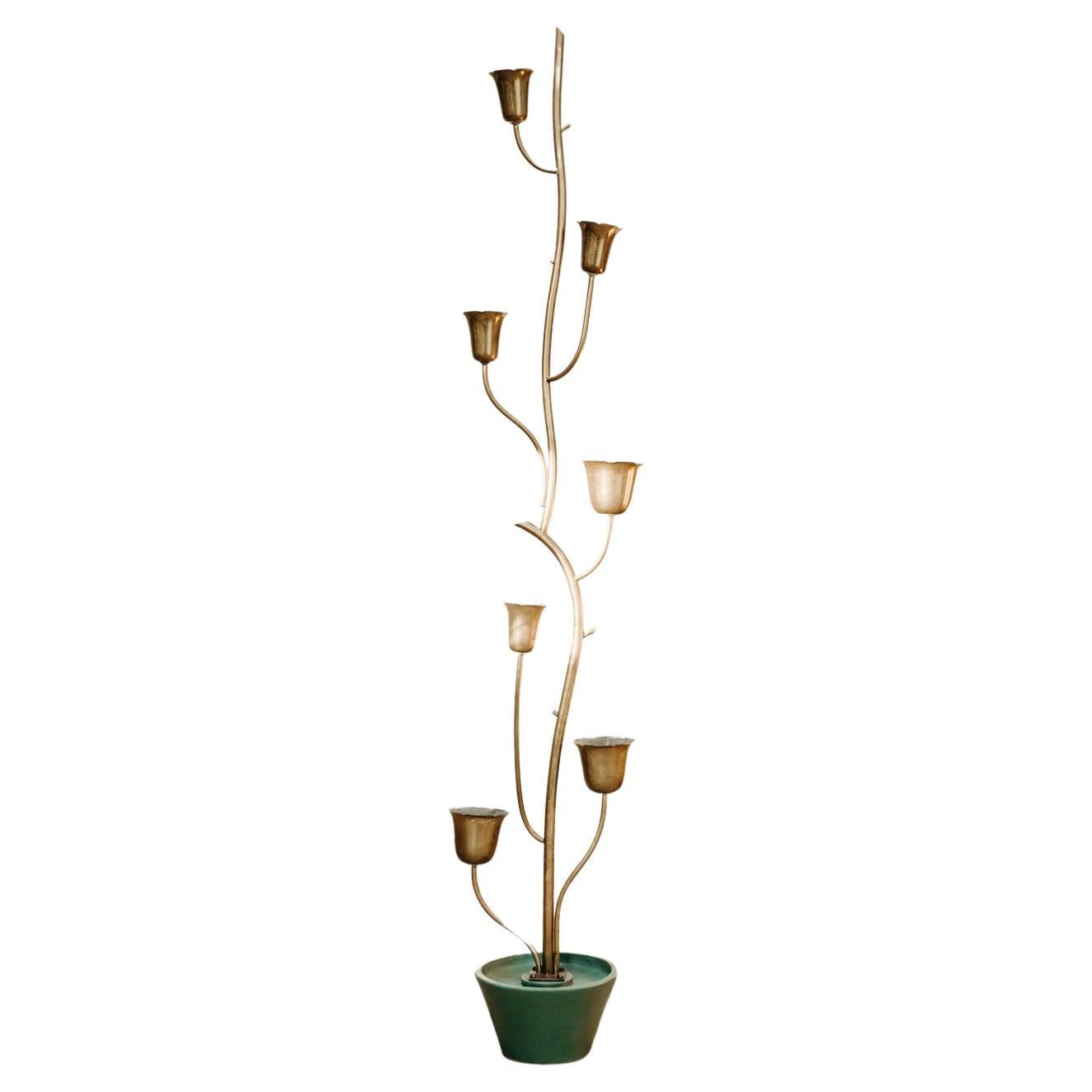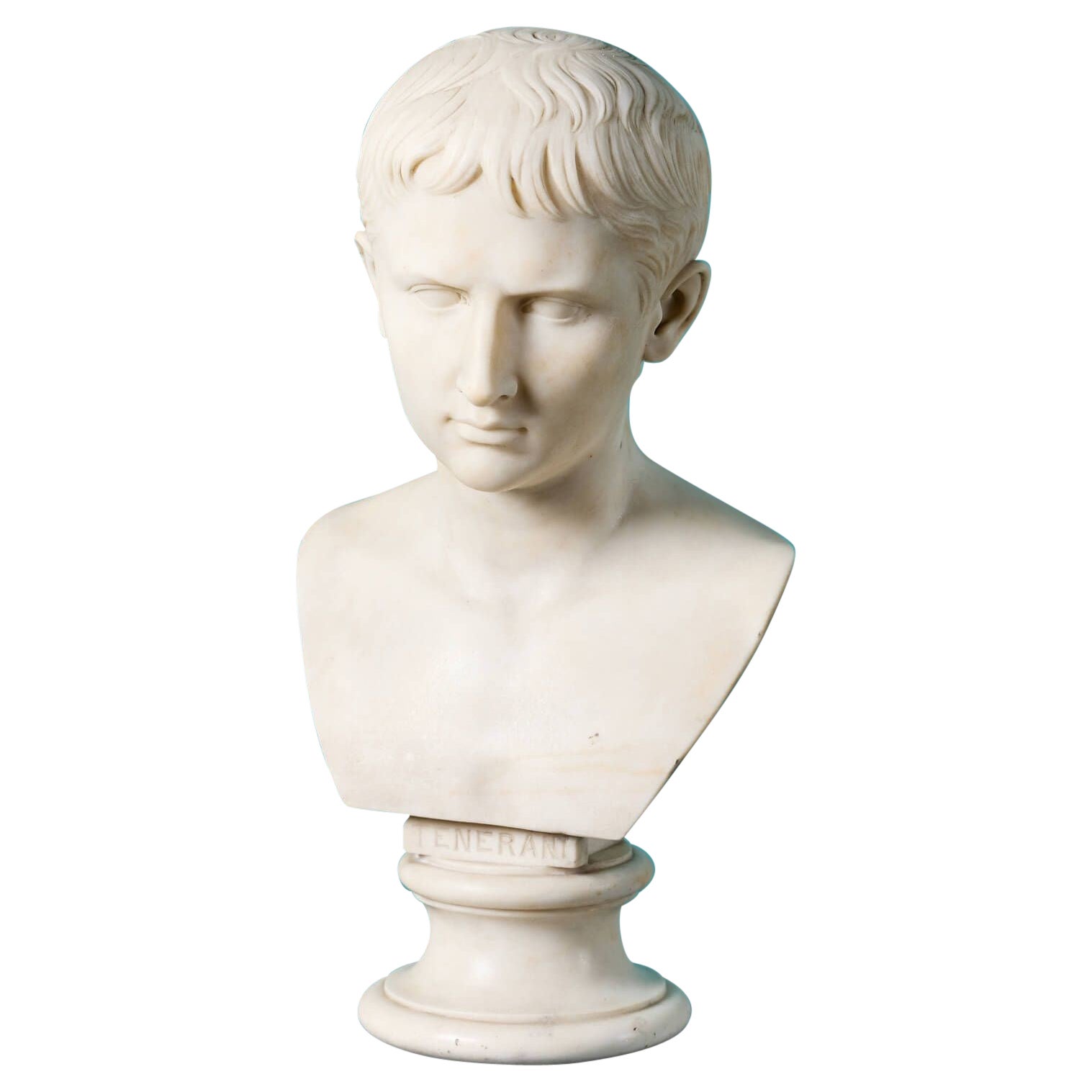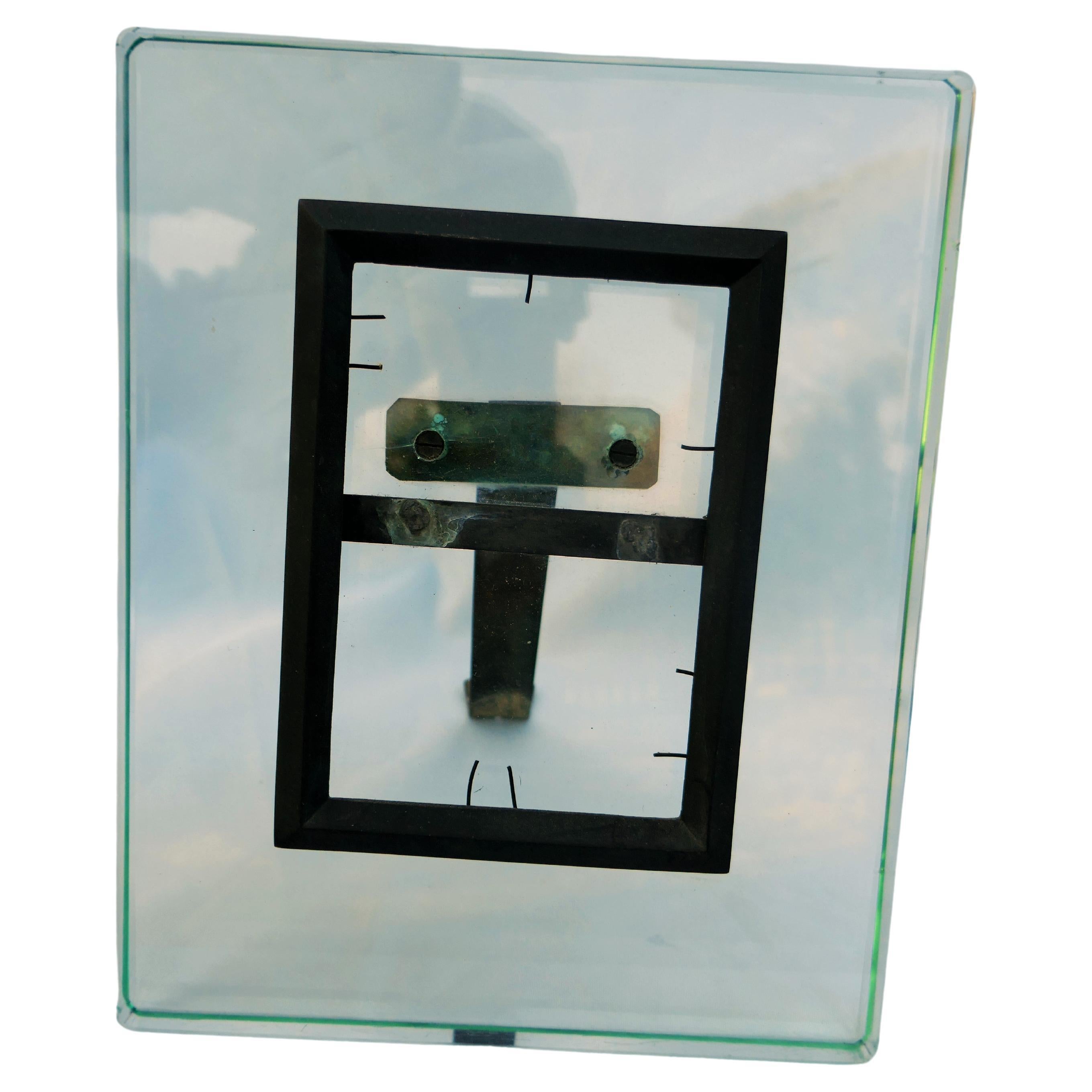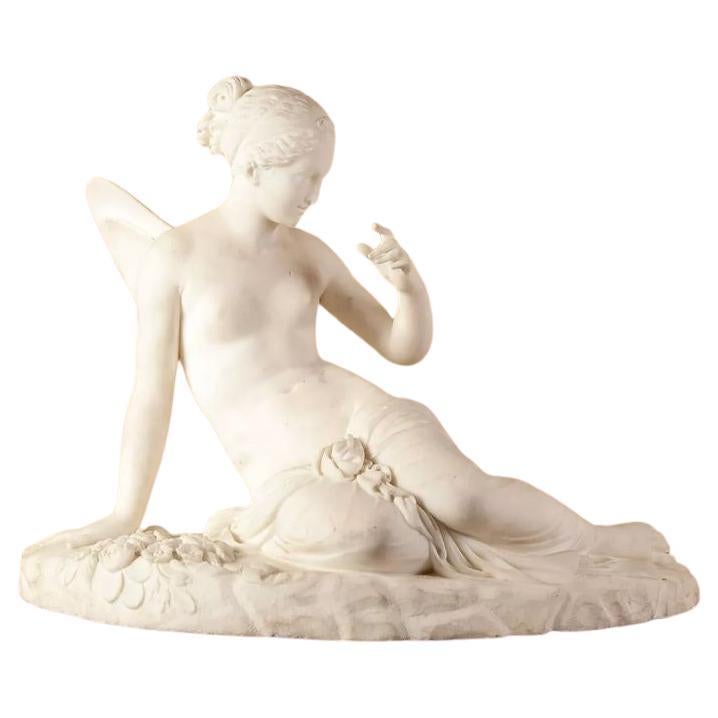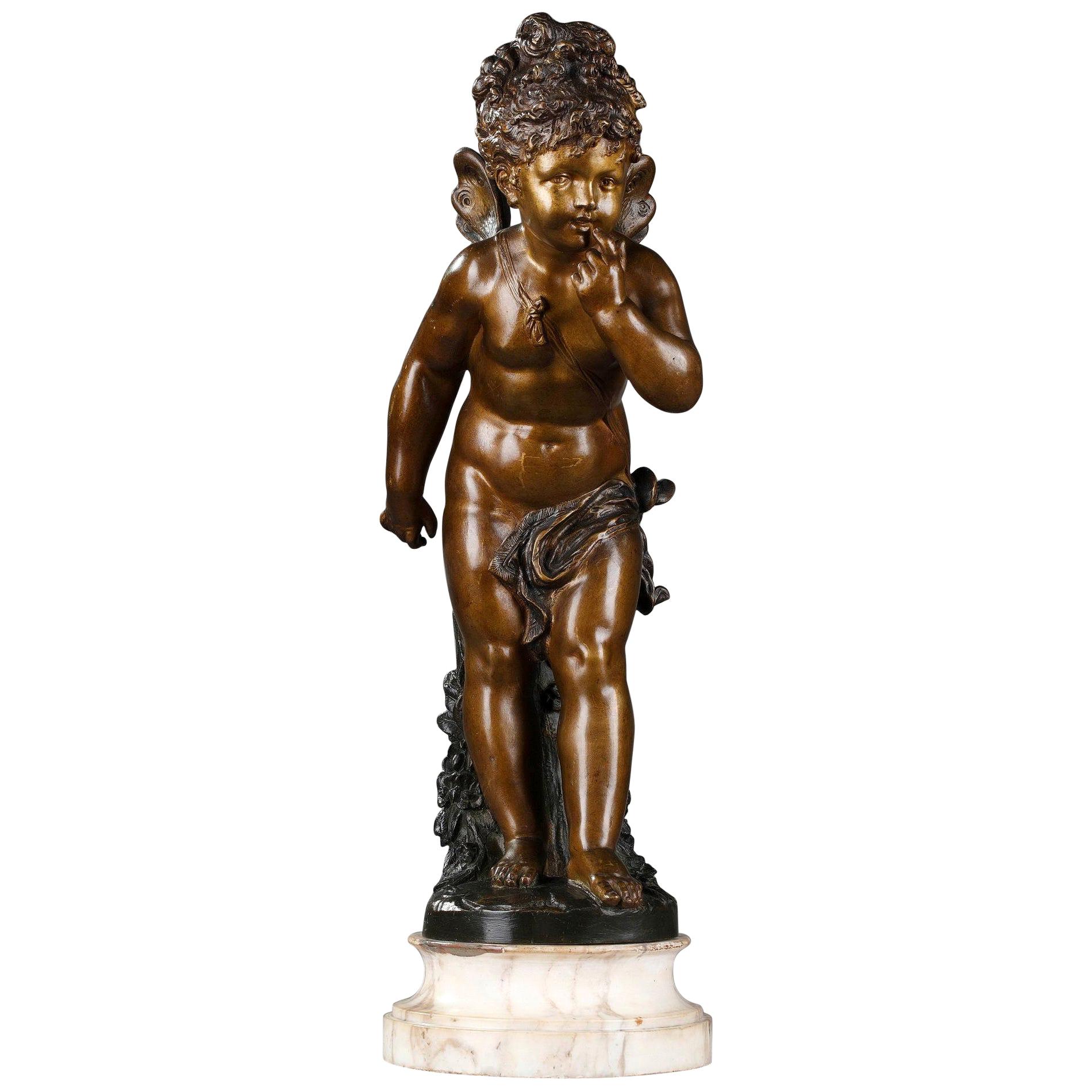Items Similar to Scagliola Figure of Psyche Abandoned Attributed to Pietro Tenerani
Want more images or videos?
Request additional images or videos from the seller
1 of 20
Scagliola Figure of Psyche Abandoned Attributed to Pietro Tenerani
About the Item
A rare Italian sculpture depicting Psyche, attributed to the Italian sculptor, Pietro Tenerani.
Pietro Tenerani (1798-1869) was a sculptor perhaps best known for his neoclassical works of the early nineteenth-century. He trained under Lorenzo Bartolini at the Accademia di Belle Arti in Carrara and with his uncle Pietro Marchetti, where he learnt how to polish and finish marble. After his early training, he won a scholarship to Rome in 1815, where he entered the studio of Bertel Thorvaldsen, considered one of the great masters of the age. He worked together with Thorvaldsen on several illustrious commissions, and soon set up his own studio. Among Tenerani’s illustrious patrons were William Cavendish, 6th Duke of Devonshire, Crown Prince Ludwig of Bavaria, Queen Victoria, and Pope Pius IX.
In 1816, Tenerani produced his first model of Psyche Abandoned under his own name, a beautifully finished work in plaster. This work transcended the more rigidly neoclassical style of the period, and instead bore the naturalism of an earlier age. It was soon acquired by the noblewoman and patron of the arts Marchesa Carlotta de’ Medici Lenzoni for her private collection. The sculpture was subsequently entered into an exhibition at the Palazzo Caffarelli in Rome, where many collectors admired and praised it for its naturalism and beauty. As a result of the exhibition, some admirers of this work requested copies to be made. It is likely that our own copy of this first work was made shortly after the exhibition; it wasn’t uncommon for a much-admired work to have copies made in both plaster and in marble. Many collectors even favoured the plaster originals, understanding that in many cases the marble versions were carved by workshop assistants rather than the master. It was Antonio Canova who popularised the practice of creating a finished work in plaster, giving the work of the marble carving to his assistants. Canova would then step in at the final stages of carving, to add his own hand to the finer details.
Tenerani’s depiction of the young Psyche captured the imagination of Italian society, but the myth of the young princess and her lover had been enjoyed since antiquity. Their story is one of the interplay between the Soul and Desire. Psyche is the personification of the soul and conveys its vulnerability when met with the tempestuous and transient nature of desire, here embodied by the deity Cupid. If Psyche and Cupid’s story concerns the soul and desire, then their ultimate union should be considered one of fate. Their story is told by Apuleius in his Metamorphoses, written in the 2nd century AD and broadly follows this narrative: Cupid’s mother, the Goddess of love Aphrodite, was driven into a fury when she discovered that her worshippers were neglecting her and instead making offerings to a young and beautiful princess, Psyche. In her rage, Aphrodite demanded that her son Cupid make Psyche fall in love with an unworthy man as a punishment for her beauty. However, Cupid is scratched by his own arrow and falls in love with Psyche himself.
They marry, yet Cupid tells his bride to never look at him, lest she be injured if she settled her gaze on a God. She complies until one evening she can no longer resist temptation, and she casts a light over her sleeping beloved with a lamp. He wakes, and in his fury at her betrayal, flees. Psyche is inconsolable and approaches the God’s mother Aphrodite and appeals to her to reunite them. She is set a series of impossible tasks by the Goddess, and when she fails the final task, at Cupid’s request the other Gods take mercy on her granting her immortality so the lovers can be reunited.
Apuleius’ story is a lesson about finding balance between matters of the body and spirit, to live in harmony. Cupid and Psyche were represented not only in this tale, but in much earlier Hellenistic Art too, which makes Tenerani the perfect master for this work.
His sculpture captures the moment in which Psyche’s beloved departs in a rage, leaving her alone. She sits on a rock, her youth emphasised in the modelling of her body and face. Her face in downcast, and her anguish is sensed not only in her expression but also in her posture. In this sculpture, Tenerani has captured the essence of the Hellenistic sculpture that he so revered at this stage of his career. Archaeological excavations in Rome had revealed ancient copies of sculptures from Greece and set the standard to which to aspire.
The drapery over her legs is reminiscent of Hellenistic sculpture insofar as it has weight to it, a quality that the eighteenth-century scholar Johann Winckelmann described as a “wet look”. Carving and modelling of this quality is indicative of a master, and this detail allowed the Tenerani to showcase his skill as a sculpture independent from his master.
In this version of the sculpture, Psyche is depicted without wings. It wasn’t unusual to find Psyche represented this way, as sculptures of this quality were commissioned by or intended for an audience who would find the subject immediately recognisable. Pietro Tenerani’s first sculpture of Psyche dated to 1817 does shows her with wings and is also modelled in plaster. Both sculptures are the same size and possess an almost identical finish, where the top layer of the plaster has been toned to give it a patina and both also display a very fine level of finish, so this work is to be regarded as a finished sculpture rather than mere modello. It is perhaps most interesting to consider how the composition developed over time in the hands of its master.
Tenerani’s Psyche Abandoned is considered one of the most revered sculptures of the nineteenth-century, so we are honoured to have such a fine version in our collection.
- Dimensions:Height: 44.89 in (114 cm)Width: 21.26 in (54 cm)Depth: 20.48 in (52 cm)
- Style:Neoclassical (Of the Period)
- Materials and Techniques:
- Place of Origin:
- Period:
- Date of Manufacture:circa 1817
- Condition:Wear consistent with age and use.
- Seller Location:London, GB
- Reference Number:
About the Seller
No Reviews Yet
Vetted Seller
These experienced sellers undergo a comprehensive evaluation by our team of in-house experts.
Established in 1989
1stDibs seller since 2015
45 sales on 1stDibs
Typical response time: 12 hours
- ShippingRetrieving quote...Ships From: London, United Kingdom
- Return PolicyThis item cannot be returned.
More From This SellerView All
- Pair of 19th Century Italian Alabaster Classical Figures of MusesLocated in London, GBA pair of very finely carved 19th century alabaster figures of muses, in classical dress, each standing on circular pedestals intricately carved with flowers and beading, Italian, c....Category
Antique Mid-19th Century Italian Neoclassical Figurative Sculptures
MaterialsAlabaster
- Large Italian Statue of a Sleeping NymphLocated in London, GBA large Italian school carrara marble sculpture depicting a sleeping nymph. The finely carved sculpture is reminiscent of a depiction of Sleeping Ariadne, popularised by the Roman copy of the Hellenistic original, the former being housed at the Vatican. Reclining on rocks, the sleeping nymph is shown draped only below the waist, and her finely modelled form is exemplified by the delicacy of her fingers. Italian, early 19th century. Before restoration.Category
Antique Early 19th Century Italian Rococo Figurative Sculptures
MaterialsStatuary Marble
- Pair of Ming Dynasty Horsemen Roof TilesLocated in London, GBA pair of Chinese Ming Dynasty (1368-1644) sancai-glazed ridge tiles modelled as horse and rider. Both tiles are glazed in rich green and amber, the horses ...Category
Antique 16th Century Chinese Ming Ceramics
MaterialsPottery
- Near Life Size Marble Crouching VenusLocated in London, GBA near life size carved marble figure of the Crouching Venus. This late 19th century copy of the iconic Hellenistic original bases its form on the crouching Venus on permanent displa...Category
Antique Late 19th Century Italian Neoclassical Figurative Sculptures
MaterialsStatuary Marble
- Aesthetic Movement Ebonised Mantel Clock Attributed to Lewis Foreman DayLocated in London, GBA magnificent Aesthetic Movement mantel clock, with an ebonised mahogany case and an exquisitely painted dial. The case embodies the style of the Aesthetic Movement, with an arched a...Category
Antique 1870s British Aesthetic Movement Mantel Clocks
MaterialsMahogany
- Attractive Bronze Figure of a Young Gypsy MaidenLocated in London, GBA 20th century bronze of a beautiful young gypsy maiden with a tambourine after the model by Claudius Marioton (1844-1919). The name Marioton and the number 126 are inscribed on the ...Category
Vintage 1920s French Art Nouveau Statues
MaterialsBronze
You May Also Like
- 1930's Italian Sculpture Attributed to Pietro ChiesaLocated in Brecht, BEElegant and chic this gilt wood and brass floral sculpture, Attributed to Pietro Chieasa, Italian artist, a rare and unique find.Category
Early 20th Century Italian Figurative Sculptures
MaterialsBrass
- Tenerani Statuary Marble Bust of a Young Augustus CaesarLocated in Wormelow, HerefordshireA finely carved statuary white marble bust of a young Augustus Caesar attributed to the workshops of 19th century Italian sculptor Pietro Tenerani (1789-1869). Also known as Young Octavian, this bust of a young Roman Emperor Augustus Caesar is after a sculpture found in the Pio Clementino Museums of the Vatican. Carved with exceptional detail, the bust is elevated on a turned socle and bears the name ‘TENERANI’ to the front. Other busts like this one after the Vatican original of the former Emperor Augustus were sculpted in the Mid-18th Century. Pietro Tenerani (1789-1869) was a notable Italian sculptor of the early 19th century. In his early career, he trained under Italian sculptor Lorenzo Bartolini, before moving to Rome where he won a scholarship as a pupil of Danish sculptor, Bertel Thorvalsden. Having honed his skills, Tenerani worked from a studio of his own in later years. William Cavendish, 6th Duke of Devonshire, Queen Victoria and Pope Pius IX...Category
Antique Mid-19th Century Italian Neoclassical Busts
MaterialsMarble, Statuary Marble
- Photograph holder attributed to Pietro Chiesa for Fontana ArteBy Pietro Chiesa, Fontana ArteLocated in Lugo, ITPhotograph holder attributed to Pietro Chiesa for Fontana Arte Micro miss in upper right corner Thank youCategory
Vintage 1940s Italian Modern Mounted Objects
MaterialsGlass
- Statuary White Marble Figure of Psyche, circa 1850Located in Tyrone, Northern IrelandA finely carved white statuary marble figure of Psyche. In Greek mythology, Psyche is the goddess of the soul and wife of Eros, god of love. She was the most beautiful girl in the w...Category
Antique 19th Century Italian Neoclassical Revival Figurative Sculptures
MaterialsStatuary Marble
- Bronze Figure of Young Psyche by Paul DuboyBy Paul DuboyLocated in Paris, FRThis brown and gold patinated bronze figure was crafted by the French sculptor Paul Duboy. It features a little girl, psyche, standing on a naturalistic base. The bronze sculpture is set upon a round marble plinth...Category
Antique 19th Century French Napoleon III Figurative Sculptures
MaterialsMarble, Bronze
- Vintage Bronze Decorative Figure of a Woman attributed to Karl HagenauerBy Karl HagenauerLocated in Bresso, Lombardy1940s. This item is made in bronze and might show slight traces of use since it's vintage, but it can be considered as in excellent original condition and ready to become a piece in ...Category
Vintage 1940s Italian Mid-Century Modern Figurative Sculptures
MaterialsBronze
Recently Viewed
View AllMore Ways To Browse
Antique Model T
Exhibition Quality Carved
Lorenzo Medici
Sculpture Of Figure Looking Up
Neoclassical Arrow
Antique Level Collectors
Antique Union Cases
Medici Lorenzo
Di Medici
Queen Of Love
Plaster Cast Art Model
Italian Scagliola
Greek Ancient Lamp
Deity Carving
Carving Deity
Antique Marble Lamps Italy
Polished Plaster
Used Victoria Lamps
